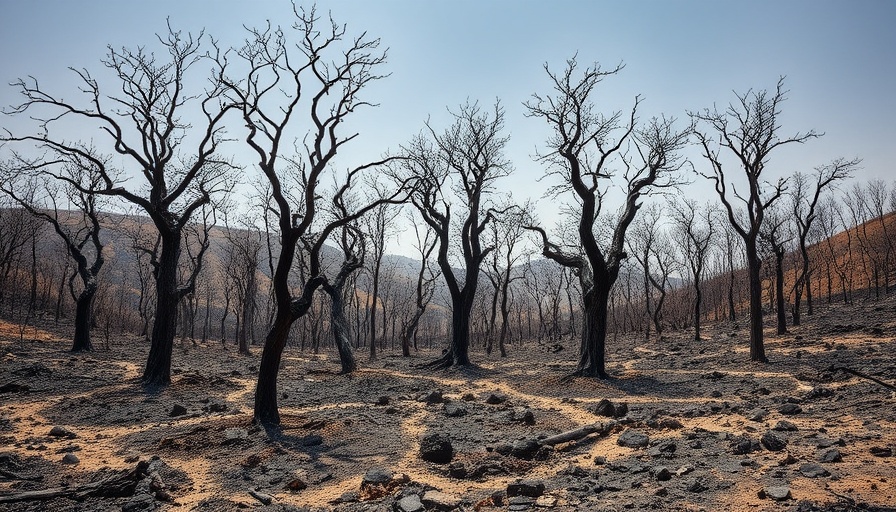
Transforming Climate Anxiety into Actionable Solutions
Climate change can often feel overwhelming, especially with the continual barrage of negative news reports highlighting impending disasters. However, the New York Times’ initiative, "50 States, 50 Fixes," is offering a refreshing perspective that steers the conversation towards positive action. This series doesn't just spotlight problems but showcases grassroots initiatives and local triumphs, encouraging communities around the U.S. to not only recognize the challenges they face but also the innovative solutions they can implement.
Highlighting Local Triumphs in Environmental Health
Every state in the U.S. is tackling climate change in unique and impactful ways. For instance, the series introduces a community in Colorado that has successfully constructed wildlife crossings, which have led to an 80% reduction in car collisions with wild animals. This substantial achievement underlines the importance of thoughtful infrastructure in protecting both human and animal life, aiding in public health and safety. In Hawaii, a community health center is integrating a prescription for nature into patient care, encouraging residents to spend time outdoors as part of their healing process. These stories provide powerful examples of how local actions yield substantial benefits, serving as a template for similar future initiatives.
Climate Coverage’s Missed Opportunities
While major outlets often highlight political failures and environmental disasters, they fail to adequately cover the significant strides being made on the ground. This oversight can lead to what health journalist Katie Burke identifies as a significant inaction problem; people's worries about climate change can quickly turn to despair when they perceive no means to effect change. By focusing more on local success stories and community-driven projects, journalists can inspire a wave of action rather than a wave of hopelessness.
Encouraging Health Journalists to Find Local Wins
The series serves as a rallying cry for health journalists. It calls on them to delve deeper into local successes surrounding climate and public health. Questions worth exploring include: What initiatives are health clinics undertaking to minimize waste? How is the promotion of public transportation improving air quality? What community measures are in place to combat climate-related health issues? By seeking out these empowering narratives, journalists can not only spread awareness but also galvanize communities to join in on the efforts.
The Broader Implications of Local Environmental Successes
Enhancing awareness of regional climate solutions can have wider implications beyond individual health benefits. As communities commit to sustainable policies, they inadvertently also boost local economies through green jobs and innovation. Moreover, success in one locality can inspire neighboring areas to replicate these initiatives, creating a domino effect of positive change. This phenomenon reinforces the notion that proactive action at a community level can lead to meaningful change on a much larger scale.
Emotional and Psychological Benefits of Climate Progress
Creating solutions to climate challenges also promotes emotional well-being within communities. Bursting forth from despair into action can significantly uplift moods and instill a sense of purpose and belonging among residents. Engaging with the environment and participating in collective efforts not only invigorates the spirit but fosters connections among people united for a common cause. Feeling empowered to make a difference can serve as a crucial form of stress management in these challenging times.
Actionable Steps for the Audience
For health fanatics and community members, the call to action is clear: get involved! Explore local environmental health initiatives, advocate for your community's participation in sustainability efforts, or even organize a neighborhood event focused on wellness and eco-friendliness. Simple actions like starting a community garden or participating in clean-up days can have an extraordinary impact. Sharing healthy recipes that utilize local produce not only promotes good eating habits but also enhances community ties. Listening to the success stories highlighted by the New York Times will leave you energized and motivated to take part in similar initiatives. Remember, every effort counts, and your contributions could help spark change.
Conclusion: Embrace Change for a Healthier Tomorrow
As we navigate the complexities of climate change, it’s crucial that we shift our focus from fatalism to proactive engagement. By capitalizing on local successes and seeking out health-centric environmental initiatives, we can create a momentum that fosters hope and drives a healthier, more sustainable future for ourselves and our neighbors. Let's take the lessons from the "50 States, 50 Fixes" series and bring them into our communities.
 Add Row
Add Row  Add
Add 




Write A Comment